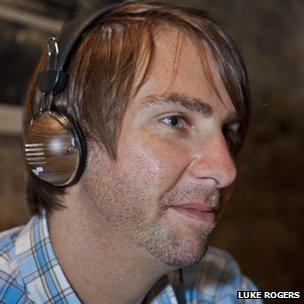Fears that music volume limits 'could be ignored'
- Published
- comments

Marc Nicholson's chronic tinnitus was caused by loud music in his job as a DJ
A safety limit on volume levels which comes into force on all new personal music players this month could be ignored by 40% of young people, says a hearing loss charity.
All personal music players and mobile phones sold in the EU must now have a sound limit of 85 decibels (dB), but users can increase it to 100dB.
Action on Hearing Loss says overexposure to loud music can trigger tinnitus.
Experts say the limit is "good news".
Tinnitus is a medical term used to describe a ringing or buzzing noise that people can hear permanently in one ear, both ears or in the head.
It is often caused by exposure to loud music and can be accompanied by hearing loss.
Paul Breckell, chief executive of Action on Hearing Loss, said the new EU standard is important because increasing numbers of young people listen to music through a personal music player.
Survey results
"I urge music lovers to consider the long-term risks of overriding the safe setting as overexposure to loud music can trigger tinnitus, and remember that a good pair of noise cancelling headphones can make all the difference."
A survey of more than 1,500 16 to 34-year-olds by Action on Hearing Loss suggests that 79% of young people are unaware of new standards coming into force this month.
Although 70% of survey respondents said they would take steps to protect themselves against tinnitus, nearly 40% said they would override the new default setting on their music devices.
In October 2008, the European Commission warned, external that listening to personal music players at a high volume over a sustained period could lead to permanent hearing damage.
As a result, the European Committee for Electrotechnical Standardisation (CENELEC), external amended its safety standard for personal music players.
Now all personal music players sold in the EU after February 2013 are expected to have a default sound limit of 85dB.
The user can choose to override the limit so that the sound level can be increased up to maximum 100dB. If the user overrides the limit, warnings about the risks must be repeated every 20 hours of listening time.
The European Commission's assessment said: "Listening to music at 80dB or less is considered safe, no matter for how long or how often personal music players are used. This sound level is roughly equivalent to someone shouting or traffic noise from a nearby road."
But turning the volume control to 120dB, which is equivalent to an aeroplane taking off nearby, is exceeding safe limits, it said.
The commission said an estimated 20% of young people are exposed to loud sounds during their leisure time - a figure which has tripled since the 1980s.
An estimated 5-10% of of people in the EU are thought to be at risk of permanent hearing loss if exposed to unsafe noise limits for five years or more.
Dr Michael Akeroyd, from the MRC Institute of Hearing Research in Glasgow, said of the new EU standard: "This is good news for the volumes of personal music players. The volumes they can give has been of concern for many years, going back to at least the advent of portable cassette players."
He added that headphones can vary in quality and design.
"Few designs of headphones remove background sounds, and indeed some designs remove none. But ear-defenders or ear-plugs can remove a substantial amount of noise. Earplug design has advanced greatly in recent years."
- Published24 January 2013
- Published14 May 2012
- Published4 May 2012